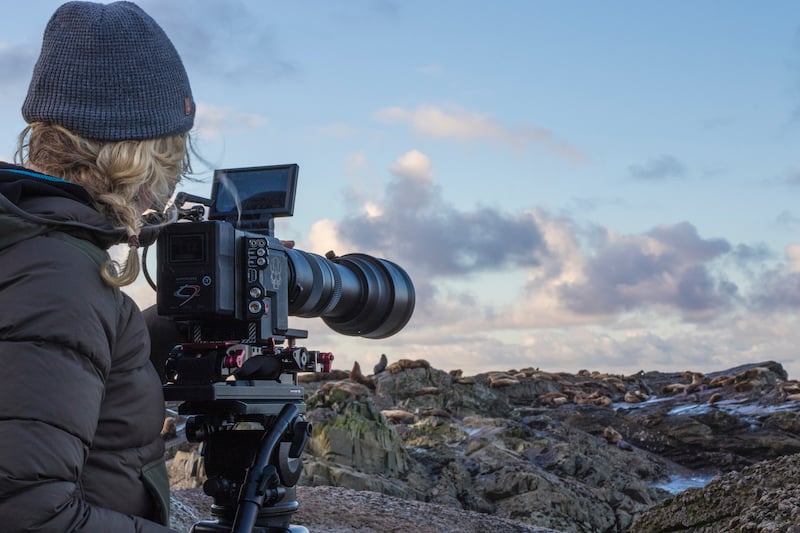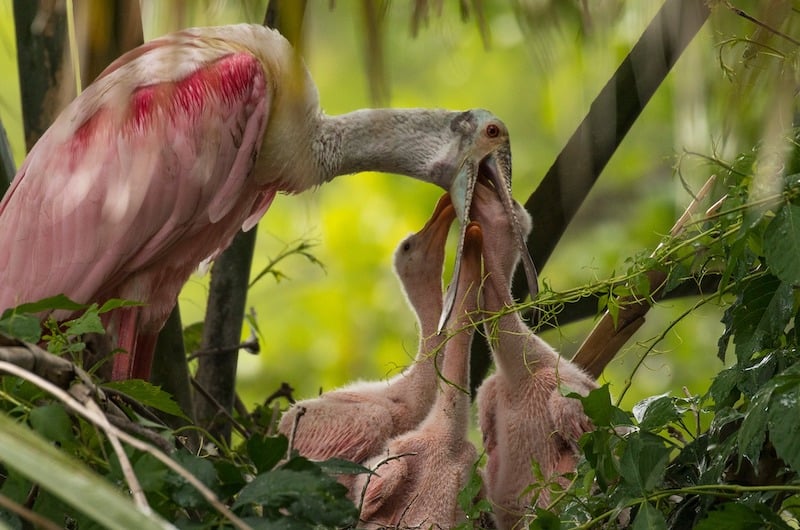
Erin Ranney on wildlife filming and how animals don’t follow script
Educator Highlights . ExplorationQ & A with wildlife cinematographer Erin Ranney
In our Educator Highlights, we go behind-the-scenes with educators who inspire us. We’re kicking off this series with an interview with wildlife camerawoman Erin Ranney, whose education and conservation efforts in Alaska and Washington State stopped us in our tracks.
We got to chat with Erin about her career as a professional tracker, video engineer, and fisherwoman. Enjoy our interview, below, and if you feel inspired, please share this article with a friend!
As always, there are resources at the end of this interview, and ways for you to stay connected to Erin’s amazing work.
Acorn Naturalists: Alright, Erin, let’s start with the inevitable question here: what are your early memories of science or science education? Did you like it?
Erin Ranney: My parents were both teachers growing up, and my Dad was always big on bringing science to the classroom. I think science in schools can be intimidating, but it doesn’t have to be. My parents are awesome and always made science playful and fun. I don’t think science has to be “formal” and “strict lines.” Especially at a young age, kids just need to go play with a magnifying glass and see what they can find.

Acorn Naturalists: That’s awesome it started so young. And was it a linear jump, from your parent’s teacher/science background to tracking, for you?
Erin Ranney: My tracking career had an informal beginning—I just learned by being outside and looking at things. I loved it, and later, ended up studying wildlife ecology for my undergrad; That’s when I started learning the nitty-gritty in scat labs, to learn & identify more formally, and then trial and error in the field.
Acorn Naturalists: Can you share a memory of “breakthrough tracking moment” from those earlier exploration days?
Erin Ranney: I remember Christmas Day one time we followed this track and were so confused because they were on their way to the highway. They were beaver tracks, and dominant male beavers will push male beavers out of lake systems—they’re so territorial. We did find the beaver, but it was dead. That was one of the first times though I remember tracking an animal to its actual self.
Acorn Naturalists: And you’re also a wildlife camerawoman, whose footage has been featured in BBC, PBS, National Geographic, the Smithsonian, I mean, wow! What is the role of film and environmental education, do you think?
Erin Ranney: A lot of times, kids just do not have access to the same kind of learning, and with science education, that can be especially true. Educational videos help brings kids in and see a world they might not otherwise get to see, and it really can be what sparks their curiosity. There are so many kids who might only get that “ah-ha” moment sparked from a video, and from there, have that curiosity drive them forward.

Acorn Naturalists: Any particular science education content you’ve been particularly excited about?
Erin Ranney: I got to hop onboard with Lizzy Daly, who does lots of stuff for BBC. She had this idea to put on live science lessons, as one way to enhance the science education that a lot of students simply were not getting. Her “Earth Live” series is incredible. She did this all free, over 100 lessons by end of series. To have that initiative and donate her time, it’s incredible.
Acorn Naturalists: You’ve filmed in some very cold places, including the Subantarctic and South Georgia. What are the challenges of wildlife filmmaking, if not, the weather itself?
Erin Ranney: Honestly, the hardest part is that animals don’t follow script—you have to be so patient and yes, sometimes it’s miserable weather too with storms at sea. It’s not uncommon to have people seasick the entire time.
Acorn Naturalists: Any advice for the aspiring tracker of wildlife cinematographer?
Erin Ranney: Be curious and try things out. Go outside and explore—the main thing though is don’t be afraid to get it wrong and fail at things. In tracking too, you’re going to guess the wrong thing a lot and that’s all part of it.

Acorn Naturalists: We have to ask. Do you have a favorite naturalist?
Erin Ranney: David Attenborough! I actually cried the first time I saw my footage with his narration over it for BBC’s Seven Worlds, One Planet. This is an in-depth Subantarctic sequence with footage of the Albatross. I had the great privilege of working with John Aitchison, and I learned a ton from him during this shoot. John was an amazing mentor and this was one of the most emotional shoots I’ve ever been a part of. We filmed for over a month, and then, to hear David Attenborough narrate—that was really special. Attenborough is an absolute legend.
Our chat with Erin concluded with some shared admiration for Attenborough. We think Erin Ranney is an absolute legend too. If you’re inspired to learn more about wildlife camerawoman and professional tracker, Erin Ranney, check out our resources and ways to stay connected below!
Further Explorations:
- Stay tuned with Erin Ranney’s latest explorations on her website or Instagram.
- Lizzy Daly’s Earth Live YouTube Series – Check out this educational series with biologist, natural history TV presenter, adventurer, and wildlife expert Lizzy Daly. Erin Ranney is featured on several of these educational videos!
- BBC: Seven Worlds One Planet, featuring footage by Erin Ranney for the South Georgia scenes.
Stay tuned for our next Educator Highlight!
Huge thank you to Erin Ranney for taking the time to chat with us. And thank you to our readers, as well. If this article inspired you, please feel free to share it with a friend!
As always, feel free to leave additional comments and questions below.

Fantastic interview! Her work as a cinematographer is inspiring. Continue to be a great advocate and advancer for the environment and wildlife. This blog is wonderful!
Thank you Latrece! We love hearing that – and Erin is wonderful!!